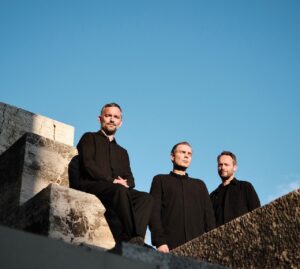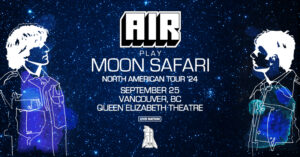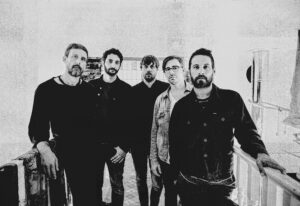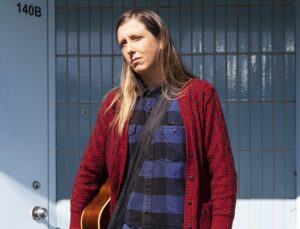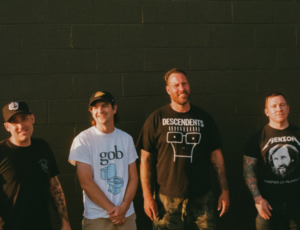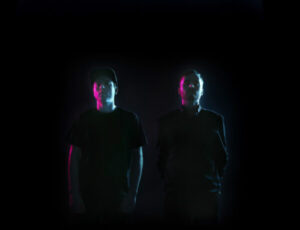
Jameson and PBR were flowing as the crowd trickled into the
Biltmore for the evening. There was no mistaking the feel and target audience of the event: this was a show for the urban alternative crowd.
The first act,
White Poppy, was a local dream pop duo, spearheaded by guitarist and singer Crystal Dorval. Their onstage presence was at first uneasy, as opening bands often are, but as the noise level rose, so did their confidence. I found it unfortunate that this promising young act’s set was the least attended, being arguably the most musical out of the three to play the night. The driving bass riffs were especially enjoyable, as they defeated any possible sterility from the drum machine tracks, and kept the music grounded amidst the huge washes of guitar and echoing vocal sound. There was a sense of purity and passion about them. Pretty as it may be, dream pop is not the most emotionally expressive form of alternative rock. Even so, White Poppy managed to come across as human and vulnerable. The music clearly meant something to them.
The
V.Vecker Ensemble, also from Vancouver, took the second slot. As the curtains were drawn for them to begin their set, a sense of anticipation swept across the room. The band was composed of two guitars, two basses, a drumkit, and a santur (a Persian dulcimer-like instrument played with hammers). Vecker himself stayed mostly on electric piano and saxophone. He stood in front with his back to the crowd, giving directions and hand signals to the band for them, acting as an indie post-rock conductor. The crowd all seemed to be thinking the same thing: “Oh yeah, this is gonna be good.”
However, as the music began in earnest, that optimism waned. Such an impressive setup would suggest that this was a musically ambitious project, but that ambition did not come across in the sounds emitting from the stage. For all of Vecker’s precise leadership, the result was more like a jam session with too many instruments and not enough music. They kept playing the same drone notes and the same four-note riffs at the same two or three dynamic levels. Each piece in their set felt like either a wonderfully exciting, tension-building beginning or ending of a song, but that all-important middle bit was sorely missing. If a song is a sandwich, then all they did was make bread.
Finally, psychedelic dub pop duo
Peaking Lights took the stage. Aaron Coyes evoked the mad scientist archetype, toiling away in his laboratory of synthesizers, while singer Indra Dunis wore her edgy post-punk vibe with pride and enthusiasm. Their music is clearly meant to be danced to, and the crowd definitely got into it. The variety of the beats kept things fresh throughout the set, however I did find there was something lacking in the individual songs.
In more mainstream styles of dance music, there is generally a strong element of composition: it takes the listener/dancer on a journey. That journey may be shallow and unchallenging, and the composition coldly calculated for maximum appeal, but it at least offers that experience to its audience. In contrast, Peaking Lights’ style is very experimental, organic, and unstructured. Paradoxically, though, it relies heavily on the musical equipment – even Dunis’ vocals and maraca were never without some effects processing. This may be somewhat unfair, but I couldn’t shake the thought that the music I was hearing was essentially made by machines rather than by human beings. This is not necessarily a bad thing, in fact it conjures up images of dancing to the noises of nature – the greatest machine ever invented. But the emphasis was more on sound than on song; traditional musicality and songwriting were sacrificed for an aural experience. Overall the appeal of Peaking Lights was clear, and there was no doubt that people enjoyed it. It was a fun night out. But whether it was a good music concert, I cannot say with as much confidence.
 Jameson and PBR were flowing as the crowd trickled into the Biltmore for the evening. There was no mistaking the feel and target audience of the event: this was a show for the urban alternative crowd.
The first act, White Poppy, was a local dream pop duo, spearheaded by guitarist and singer Crystal Dorval. Their onstage presence was at first uneasy, as opening bands often are, but as the noise level rose, so did their confidence. I found it unfortunate that this promising young act’s set was the least attended, being arguably the most musical out of the three to play the night. The driving bass riffs were especially enjoyable, as they defeated any possible sterility from the drum machine tracks, and kept the music grounded amidst the huge washes of guitar and echoing vocal sound. There was a sense of purity and passion about them. Pretty as it may be, dream pop is not the most emotionally expressive form of alternative rock. Even so, White Poppy managed to come across as human and vulnerable. The music clearly meant something to them.
The V.Vecker Ensemble, also from Vancouver, took the second slot. As the curtains were drawn for them to begin their set, a sense of anticipation swept across the room. The band was composed of two guitars, two basses, a drumkit, and a santur (a Persian dulcimer-like instrument played with hammers). Vecker himself stayed mostly on electric piano and saxophone. He stood in front with his back to the crowd, giving directions and hand signals to the band for them, acting as an indie post-rock conductor. The crowd all seemed to be thinking the same thing: “Oh yeah, this is gonna be good.”
However, as the music began in earnest, that optimism waned. Such an impressive setup would suggest that this was a musically ambitious project, but that ambition did not come across in the sounds emitting from the stage. For all of Vecker’s precise leadership, the result was more like a jam session with too many instruments and not enough music. They kept playing the same drone notes and the same four-note riffs at the same two or three dynamic levels. Each piece in their set felt like either a wonderfully exciting, tension-building beginning or ending of a song, but that all-important middle bit was sorely missing. If a song is a sandwich, then all they did was make bread.
Finally, psychedelic dub pop duo Peaking Lights took the stage. Aaron Coyes evoked the mad scientist archetype, toiling away in his laboratory of synthesizers, while singer Indra Dunis wore her edgy post-punk vibe with pride and enthusiasm. Their music is clearly meant to be danced to, and the crowd definitely got into it. The variety of the beats kept things fresh throughout the set, however I did find there was something lacking in the individual songs.
In more mainstream styles of dance music, there is generally a strong element of composition: it takes the listener/dancer on a journey. That journey may be shallow and unchallenging, and the composition coldly calculated for maximum appeal, but it at least offers that experience to its audience. In contrast, Peaking Lights’ style is very experimental, organic, and unstructured. Paradoxically, though, it relies heavily on the musical equipment – even Dunis’ vocals and maraca were never without some effects processing. This may be somewhat unfair, but I couldn’t shake the thought that the music I was hearing was essentially made by machines rather than by human beings. This is not necessarily a bad thing, in fact it conjures up images of dancing to the noises of nature – the greatest machine ever invented. But the emphasis was more on sound than on song; traditional musicality and songwriting were sacrificed for an aural experience. Overall the appeal of Peaking Lights was clear, and there was no doubt that people enjoyed it. It was a fun night out. But whether it was a good music concert, I cannot say with as much confidence.
Jameson and PBR were flowing as the crowd trickled into the Biltmore for the evening. There was no mistaking the feel and target audience of the event: this was a show for the urban alternative crowd.
The first act, White Poppy, was a local dream pop duo, spearheaded by guitarist and singer Crystal Dorval. Their onstage presence was at first uneasy, as opening bands often are, but as the noise level rose, so did their confidence. I found it unfortunate that this promising young act’s set was the least attended, being arguably the most musical out of the three to play the night. The driving bass riffs were especially enjoyable, as they defeated any possible sterility from the drum machine tracks, and kept the music grounded amidst the huge washes of guitar and echoing vocal sound. There was a sense of purity and passion about them. Pretty as it may be, dream pop is not the most emotionally expressive form of alternative rock. Even so, White Poppy managed to come across as human and vulnerable. The music clearly meant something to them.
The V.Vecker Ensemble, also from Vancouver, took the second slot. As the curtains were drawn for them to begin their set, a sense of anticipation swept across the room. The band was composed of two guitars, two basses, a drumkit, and a santur (a Persian dulcimer-like instrument played with hammers). Vecker himself stayed mostly on electric piano and saxophone. He stood in front with his back to the crowd, giving directions and hand signals to the band for them, acting as an indie post-rock conductor. The crowd all seemed to be thinking the same thing: “Oh yeah, this is gonna be good.”
However, as the music began in earnest, that optimism waned. Such an impressive setup would suggest that this was a musically ambitious project, but that ambition did not come across in the sounds emitting from the stage. For all of Vecker’s precise leadership, the result was more like a jam session with too many instruments and not enough music. They kept playing the same drone notes and the same four-note riffs at the same two or three dynamic levels. Each piece in their set felt like either a wonderfully exciting, tension-building beginning or ending of a song, but that all-important middle bit was sorely missing. If a song is a sandwich, then all they did was make bread.
Finally, psychedelic dub pop duo Peaking Lights took the stage. Aaron Coyes evoked the mad scientist archetype, toiling away in his laboratory of synthesizers, while singer Indra Dunis wore her edgy post-punk vibe with pride and enthusiasm. Their music is clearly meant to be danced to, and the crowd definitely got into it. The variety of the beats kept things fresh throughout the set, however I did find there was something lacking in the individual songs.
In more mainstream styles of dance music, there is generally a strong element of composition: it takes the listener/dancer on a journey. That journey may be shallow and unchallenging, and the composition coldly calculated for maximum appeal, but it at least offers that experience to its audience. In contrast, Peaking Lights’ style is very experimental, organic, and unstructured. Paradoxically, though, it relies heavily on the musical equipment – even Dunis’ vocals and maraca were never without some effects processing. This may be somewhat unfair, but I couldn’t shake the thought that the music I was hearing was essentially made by machines rather than by human beings. This is not necessarily a bad thing, in fact it conjures up images of dancing to the noises of nature – the greatest machine ever invented. But the emphasis was more on sound than on song; traditional musicality and songwriting were sacrificed for an aural experience. Overall the appeal of Peaking Lights was clear, and there was no doubt that people enjoyed it. It was a fun night out. But whether it was a good music concert, I cannot say with as much confidence. 